You’ve spent hours smoking a pork butt, but how do you know when it’s done?
This guide will help you determine when it’s time to pull your pork butt off the smoker for the best pulled pork! I’ll share the ideal temps, plus a few tricks I’ve learned over the years to determine when a pork butt is done.
The best internal temperature for pulled pork
The USDA recommends that pork be cooked to a minimum internal temperature of 145°F for it to be safe to eat, but if you pull a pork butt off the smoker at 145°F internally, you are going to end up with a tough, inedible hunk of meat.
Pork butts (or shoulders) are full of connective tissue, fat, and collagen. Similar to other large cuts like brisket, a pork butt needs time to break down before you are going to get that tender, shreddable pulled pork you know and love.
You are shooting for a minimum internal temperature of 195°F, but some butts will go all the way to 205°F internal before they’re really done.
Pork butts can finish cooking at different temperatures. Some butts have more fat than others, and some take a bit longer to finish than others.
I’ve found that 200°F is a safe bet for just about any butt. You may end up needing to use a bit more effort to pull some butts at this temperature, but you almost eliminate the risk of it being undercooked if you let it get all the way up over 200°F.
You don’t want to let your pork butt get over 205°F. Once it gets that high, the meat will start to get mushy fast. It’s not the end of the world if you’re making sandwiches or tacos, but you won’t have that beautiful, shredded pulled pork you may be aiming for.
How to determine when your pork butt is done
The best way to decide if your pork butt is done is to test for tenderness. I like to use an instant-read meat probe for this, but a skewer or toothpick will work in a pinch.
You want your pork butt to be what we call “probe tender”.
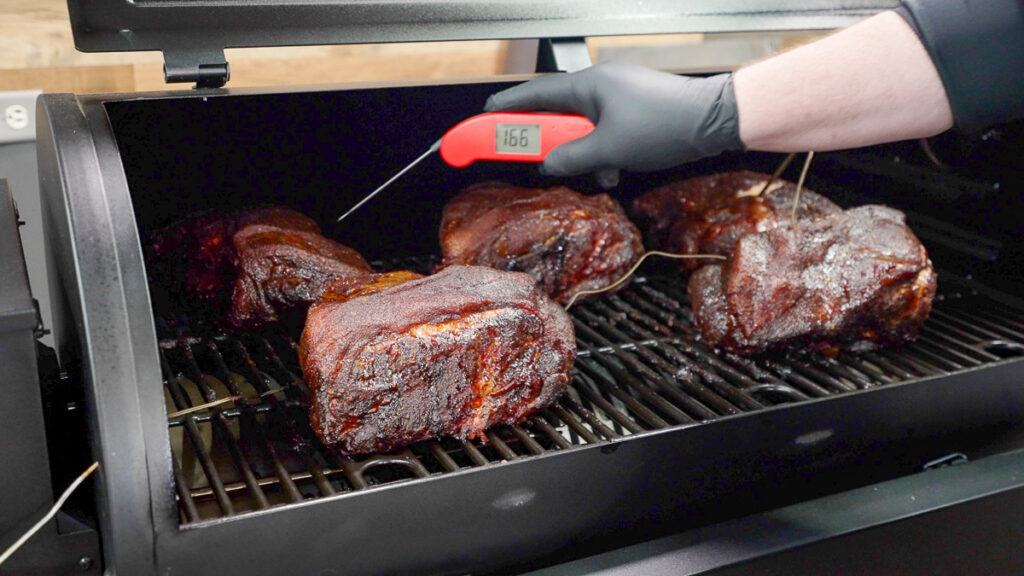
When a pork butt is probe tender, it should be soft enough that a probe can slide in and out of the meat as if it was sliding into a stick of softened butter.
Another trick I’ve learned over the years is to judge the doneness based on the bone. If you’re smoking a bone-in pork butt, the bone should slide out of the meat and come out clean. You shouldn’t have to pull very hard to remove the bone from the meat. If you feel a lot of resistance, just let it keep smoking.
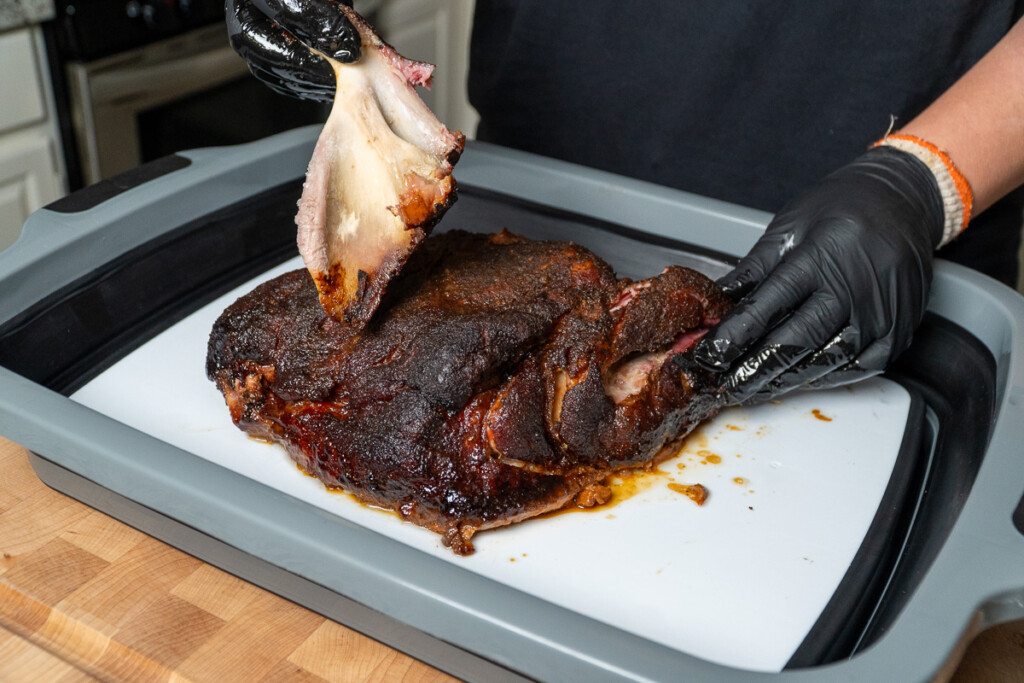
When the bone comes out completely clean you can be sure that you did it right.
What’s the ideal smoker temperature?
When you are smoking a pork butt low and slow, the smoker temperature will be between 225°F and 275°F. The meat will cook slower at this temperature, giving the collagen more time to gelatinize and the connective tissue more time to break down.
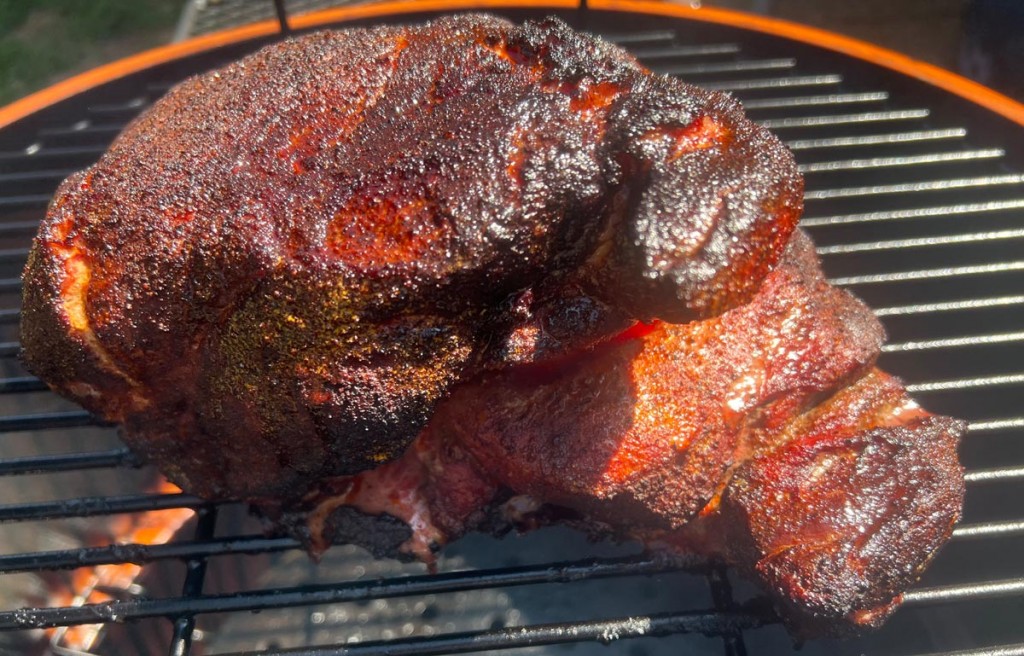
Compition style pork butt.
These lower temperatures are great for generating more smoke flavor, especially on pellet grills which struggle to get much smoke when running over 250°F.
If you are smoking your pork butt hot and fast, you will need to let it cook as long as possible. Hot and fast temperatures range anywhere from 300°F up to 375°F and will cause your pork butt to cook faster.
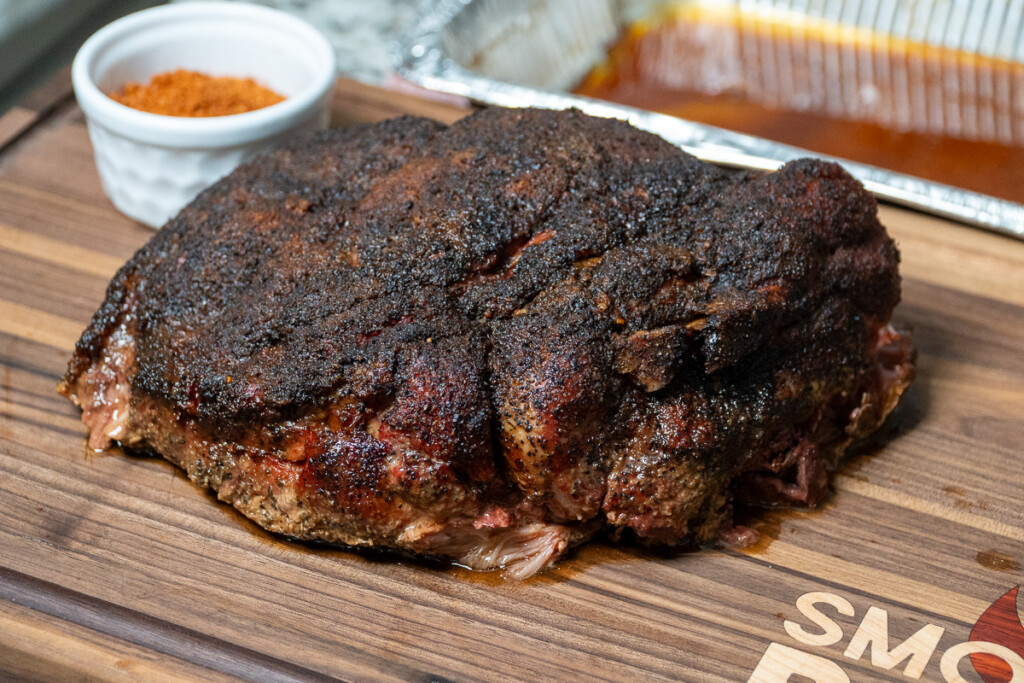
Hot and fast pulled pork.
Smoking meat hot and fast can cut your cooking time in half, but you have to remember that the fat still needs to be rendered and that connective tissue needs to break down.
I’ve found that a final internal temperature on a hot and fast pork butt needs to be up over 200°F to ensure it’s fully tender, but some butts can go all the way up to 205°F before they’re really done.
Pork butt stall temp explained
When smoking pork butt low and slow, it’s normal to see the internal temperature rise steadily over the first few hours until it reaches around 160-165°F, at which point it can stall for multiple hours.
This ‘stall’ has caused many amateur pitmasters to panic as they question whether the food will be ready before the guests arrive.
So long as you know to expect the stall, there’s no reason to panic though. You can decide to do nothing and go for a simple no-wrap pork butt. I love the simplicity of this approach, and it’s also going to get you the best bark, and smoke flavor.
Many people prefer to wrap the pork butt at this point, which can help reduce cooking time, and it’s also a great chance to add flavor and lock in the moisture.
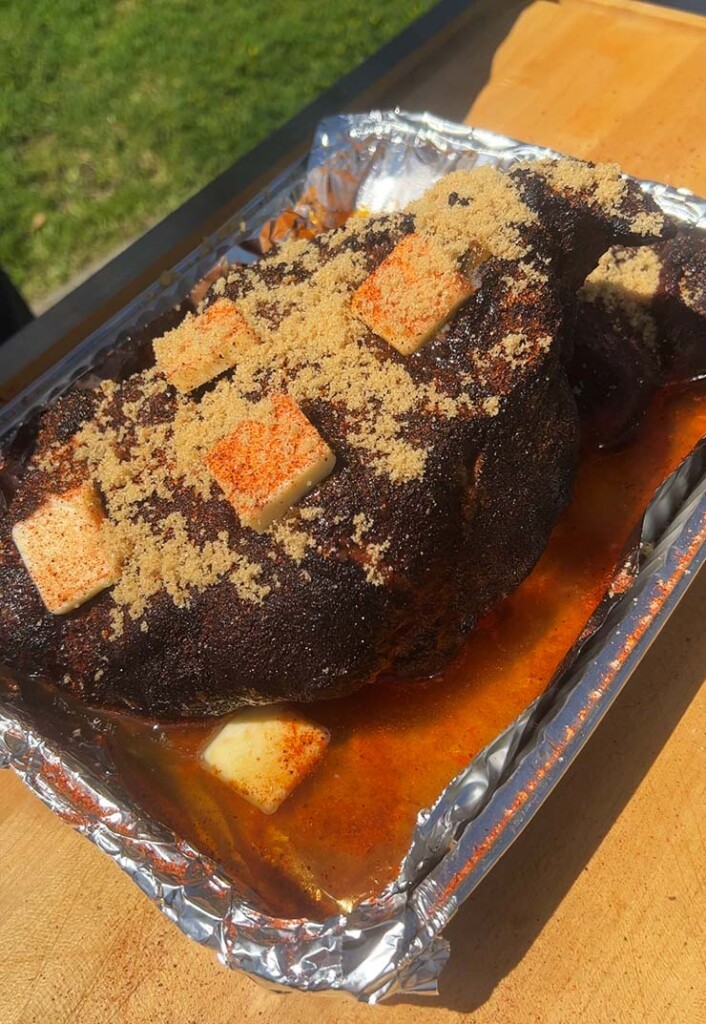
You can wrap it in butcher paper, sheets of aluminum foil, or my personal favorite is an aluminum tray with foil over the top. I like to experiment with different ingredients when I wrap, like butter, brown sugar and extra BBQ rub.
The best way to monitor temp on a pork butt
When you’re smoking big hunks of meat like pork butts, you need to get yourself a meat probe. Going by feel is great when you’ve been cooking for years, but knowing the temperature is helpful even if you have the ability to feel when something is done.
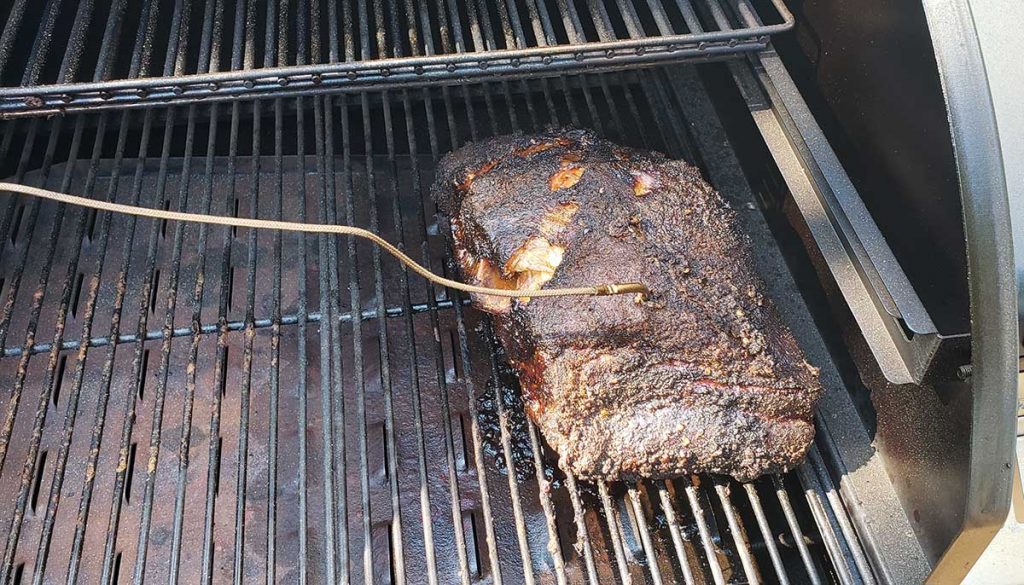
There are a number of different meat thermometers and probes on the market, and each type has its pros and cons. Here is a quick breakdown of the types of probes out there and my favorites in each category:
Instant-read meat thermometers
My personal favorite type of probe is an instant-read thermometer. They’re easy to use, fit in your pocket, and can be used for multiple things. I also love them because they’re great for testing for probe-tenderness on large cuts like briskets and pork butts.
This style of probe is available in digital and analog varieties, and depending on your budget, you can find options at many different price points.
The instant-read probe that I reach for the most is the ThermoWorks Thermapen ONE. It takes a temperature reading in less than a second and has a backlit digital display that is easy to read whether it’s daytime or nighttime. They are a bit pricer than some other brands on the market, but if you are looking for a quality probe that will last you years then ThermoWorks is the way to go.
Check out our round-up of The Best Instant-Read Temperature Probes to learn more about the options available.
Wired temperature probes
If you want a probe that will constantly monitor the temperature of the meat during the entire cook, you may want to consider a wired temperature probe.
Many pellet grills and smokers come with integrated temperature probes that connect directly to the smoker and give you a temperature reading in real time, but there are standalone products on the market as well.
Typically I prefer to use the probes that connect directly to the pellet grill, but if I’m smoking on my offset or a charcoal grill then I lean towards the ThermoWorks Signals. It has a 4-probe capacity so you can use it on multiple things as once.
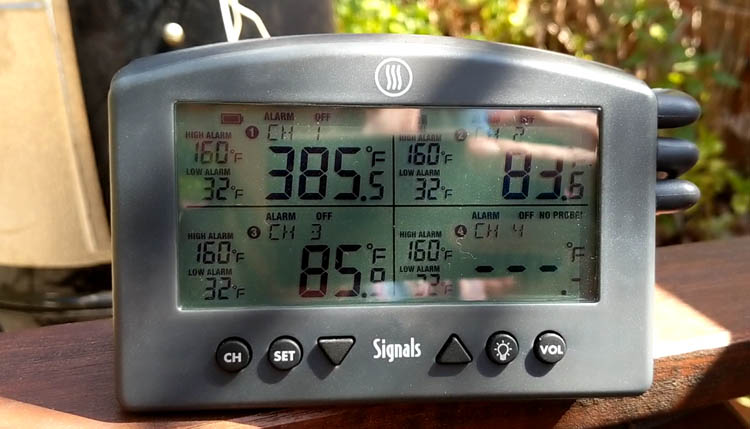
Wireless temperature probes
The latest craze in the meat probe world is the wireless temperature probe. This style of thermometer is inserted into your meat at the start of the cooking process, similar to the wired probes I mentioned above. The biggest difference is that they connect to your phone via WiFi or Bluetooth. This eliminates the need for wires hanging out of your smoker for the entire cook, plus you can monitor the temperature directly from your phone.
The most popular one on the market is the MEATER+.
If you want to learn more about the various options on the market, but sure to check out our round-up of The 6 Best Smoker Thermometers.
Did you miss our previous article...
https://manstuffnews.com/backyard-grilling/the-25-best-meats-to-smoke-from-beginner-to-expert
 Backyard GrillingWeekend WarriorsAdvice from DadBeard GroomingTV Shows for Guys4x4 Off-Road CarsMens FashionSports NewsAncient Archeology World NewsPrivacy PolicyTerms And Conditions
Backyard GrillingWeekend WarriorsAdvice from DadBeard GroomingTV Shows for Guys4x4 Off-Road CarsMens FashionSports NewsAncient Archeology World NewsPrivacy PolicyTerms And Conditions
